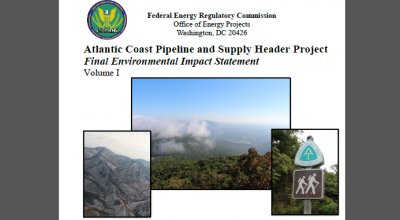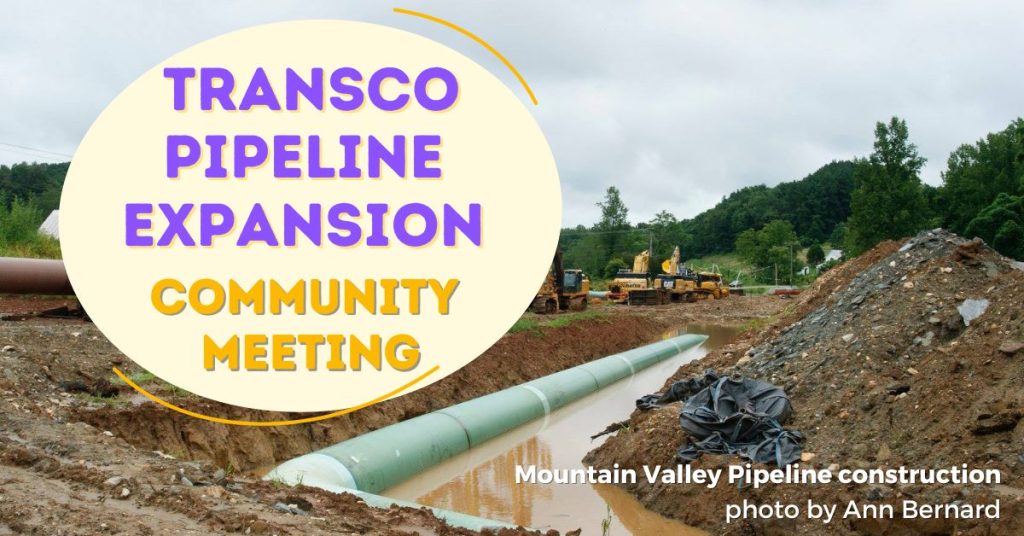FERC’s final Atlantic Coast Pipeline report a sham
Citizens turn to states to scrutinize environmental impacts

Contact:
Cat McCue, Appalachian Voices communications director, cat@appvoices.org, 434-293-6373
More contacts listed below
The Trump administration’s final environmental report issued today for the Atlantic Coast Pipeline, which would carry fracked-gas through West Virginia, Virginia and North Carolina, utterly fails to independently assess whether the project is even needed. This is the core issue upon which all other considerations of the controversial project are based, says a coalition of community groups and legal and technical experts.
The Federal Energy Regulatory Commission relies solely on the project developer’s claims of need for the 600-mile, $5.2 billion pipeline, which would yield substantial profit for Dominion Energy and the other private companies behind the project, while the public would be saddled with the financial, environmental and health risks.
“FERC’s action is an affront to American democracy, ignoring the thousands of citizens who participated in the public comment process and handing over the private property rights of hundreds of families to corporate interests. As landowners and business leaders, as ratepayers and conservationists, as parents and grandparents, we insist that the state agencies serve the public trust and rigorously examine the impacts of this pipeline in full view of the public,” says Lew Freeman, a Highland County resident and executive director of the Allegheny-Blue Ridge Alliance. The coalition comprises 52 local community groups and other organizations in Virginia and West Virginia.
FERC has authority to grant the power of eminent domain for interstate projects, but by law must first determine that the projects serve the public interest. The agency’s Final Environmental Impact Statement for the Atlantic Coast Pipeline fails to do so, says the alliance, whose member groups represent thousands of citizens, including hundreds of families along the pipeline route who are facing the taking of their land against their will.
The alliance points to numerous studies in recent years showing that the gas and utility sector is overbuilding natural gas infrastructure and that electricity demand is projected to grow much less than the pipeline developer’s inflated projections. These analyses are ignored in the impact statement.
The coalition also condemns the agency for glossing over the profound and permanent harm to water resources and drinking water supplies, forest ecosystems, wildlife and endangered species habitat, historic sites, agricultural resources, public lands including the Appalachian Trail and Blue Ridge Parkway, and local economies. The pipeline would also significantly worsen climate change impacts in the region due to the greenhouse gas emissions of drilling, producing, transporting and burning natural gas.
“Regardless of FERC’s decision, the Atlantic Coast Pipeline is not a done deal. Far from it,” says Freeman. “State leaders in Virginia, West Virginia and North Carolina will soon decide whether to grant water quality permits for the project. We call upon each state to give this project the environmental scrutiny it requires, and that they are obligated to do.”
A significant red flag for the coalition is FERC’s reliance on Dominion’s pledges to mitigate harm to water resources rather than requiring the company to provide upfront detailed plans to be shared with the public prior to granting federal certification and the power of eminent domain. The coalition has repeatedly expressed concerns that the standard control measures are insufficient to protect water resources given the scale of the pipeline proposal and the steep and highly erodible mountainsides that must be excavated during construction.
Coalition members are now concerned that state environmental agencies are similarly planning to approve the Atlantic Coast Pipeline before there is a thorough and public vetting of detailed water pollution prevention plans.
In Virginia, in particular, the Department of Environmental Quality has stated it will review those plans (stormwater management and erosion and sediment control plans) separately from its review under the Clean Water Act Section 401. As a result, the State Water Control Board’s decision whether to certify that construction of the Atlantic Coast Pipeline will not harm state waters will not be informed by the essential details that the erosion and runoff control plans should provide.
Key points from the Final Environmental Impact Statement:
- Need: FERC fails to make an independent assessment of the need for the ACP, instead relying on the developer’s claims that the project should be built. In doing so, it short circuits any meaningful consideration of the alternatives that could avoid or minimize the harm caused by this project.
- Public lands. The ACP would cross 21 miles of national forest, destroying 430 acres and threatening the survival of seven federally listed species and native brook trout. The project would be a disaster for the mountain and forest headwaters of the Potomac and James rivers.
- Public process. The FEIS fails to correct or address the numerous, substantial defects in the draft EIS that government agencies and citizens alike pointed out during the public comment period. In addition, the final document fails to incorporate significant new information that has come to light since the end of the public comment period on April 6, including more than 400 pages submitted in May.
- Climate: The FEIS continues to ignore the lifecycle greenhouse gas emissions of the project. It entirely fails to consider emissions from fracking that this massive pipeline would trigger and seriously discounts the emissions from burning the natural gas.
- Environmental justice: The FEIS notes that the Buckingham Compressor Station #2 could have serious health and safety impacts on three census tracts within one mile with predominantly low-income, minority populations, yet claims the impacts would be temporary or mitigated without adequately detailing the mitigation plans or considering any impact to safety or property values in those communities.
- Forests: Operation of the ACP (and the companion “Supply Header Project”) would have long-term or permanent effects on about 3,456 acres, including about 2,744 acres of upland forest (deciduous, coniferous and mixed). The recovery time for a closed canopy of mature forest and wildlife habitat could take up to a century or more.
- Mountain slopes: The project would cross more than 100 miles of slopes greater than 20 percent. Constructing the pipeline and access roads in steep terrain or areas prone to landslide increases the potential for landslides to occur.
- Ridgetop removal: The FEIS does not require Dominion to make any changes to minimize ridgetop removal, which would impact approximately 38 miles of ridgetop and result in 247,000 trips by large dump trucks to remove the overburden.
- Alternatives: The FEIS completely fails to even consider renewable energy as an alternative to this project.
MORE CONTACTS:
General/Virginia
Lew Freeman, ABRA chair and executive director, lewfreeman@gmail.com, 540-468-2769
General/West Virginia
Angie Rosser, West Virginia Rivers Coalition executive director, arosser@wvrivers.org, 304-437-1274
Need; Economics; National Environmental Policy Act process
Claudine McElwain, Southern Environmental Law Center communications, cmcelwain@selcva.org, 434-977-4090
Public lands (national forest, Blue Ridge Parkway, Appalachian Trail)
Ernie Reed, Wild Virginia board president, lec@wildvirginia.org, 434-971-1647
Environmental justice
Jeeva Abbate, Yogaville Environmental Solutions, jeeva@yogaville.org, 703-626-6385
********
The Allegheny Blue-Ridge Alliance is a coalition of 52 organizations in Virginia and West Virginia, founded in September 2014, that opposes the proposed Atlantic Coast Pipeline because of the ecological and economic harm it would cause the affected region, communities and landowners. www.abralliance.org



